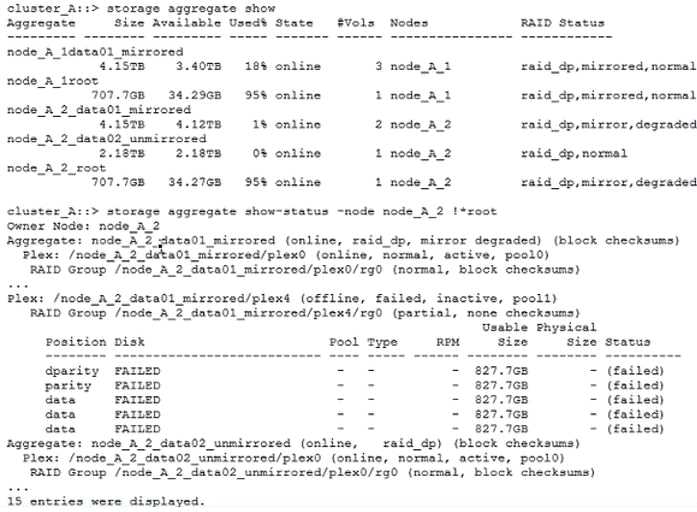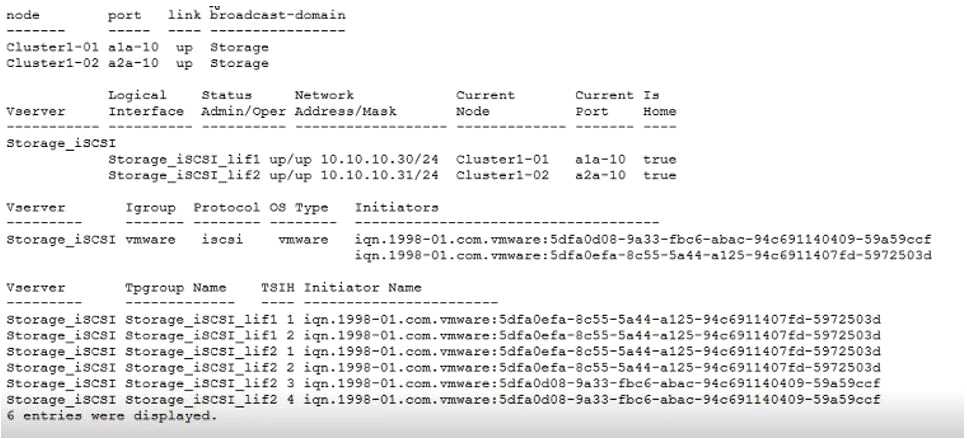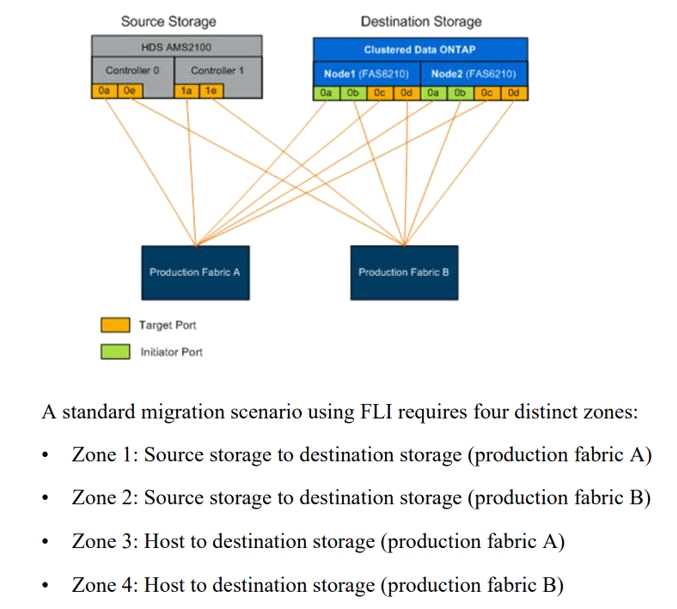NetApp ns0-520 practice test
NetApp Certified Implementation Engineer - SAN, ONTAP Exam
Last exam update: Jul 20 ,2024
Question 1
You are testing FCP paths failures on a 2-node Netapp AFF All SAN Array and verify that persistent
ports are correctly enabled. Before testing, a host sees four optimized paths to a LUN. You perform a
node takeover and re-check the host.
Which statement is true after the node takeover?
- A. The host sees four optimized paths to the LUN
- B. The host sees two non-optimized paths and two dead paths to the LUN
- C. The host sees two optimized paths and two non-optimized paths to the LUN
- D. The host sees two optimized paths and two dead paths to the LUN
Answer:
A
Explanation:
Support for persistent ports
Beginning in ONTAP 9.8, persistent ports are enabled by default on All SAN Arrays (ASAs) that are
configured to use the FC protocol. Persistent ports are only available for FC and require zone
membership identified by World Wide Port Name (WWPN).
Persistent ports reduce the impact of takeovers by creating a shadow LIF on the corresponding
physical port of the HA partner. When a node is taken over, the shadow LIF on the partner node
assumes
the
identity of the original LIF, including the WWPNe. Before the status of path to the taken over node is
changed to faulty, the shadow LIF appears as an Active/Optimized path to the host MPIO stack, and
I/O
is
shifted. This reduces I/O disruption because the host always sees the same number of paths to the
target, even during storage failover operations.
You can find more information on this link:
https://docs.netapp.com/allsan/index.jsp?topic=%2Fcom.netapp.doc.dot-asa-config%2FGUID-646B3CFD-9E00-491A-A02E-F1668C5C9DBA.html
Question 2
While changing the network connections on your ONTAP cluster from twinax to fiber, the ports
experience network connectivity issues. You want to verify which speeds the ports support and
ensure
that
you
have supported transceivers. In this scenario which two actions would accomplish this task (choose
two)
- A. Use hardware universe to determine the supported transceivers
- B. Use the interoperability matrix tool to determine the supported port speeds
- C. Use hardware universe to determine the supported port speeds
- D. Use the interoperability matrix tool to determine the supported transceivers
Answer:
A, C
Explanation:
Hardware universe will show information about port speeds and transceiver compatbility
You can find more information on this link:
https://hwu.netapp.com/Resources/hwu_ug.pdf
(page 73)
Question 3
After performing failover testing on a newly deployed MetroCluster configuration, some aggregates
remain in a degraded state. Referring to the exhibit, which statement is true?
A. The MetroCluster Tiebreaker software is misconfigured
B. The ONTAP Mediator service is misconfigured
C. A cluster switch is powered off
D. A disk shelf is powered off
Answer:
D
Explanation:
The aggregate with drives on the powered-off shelf should have a degraded RAID status, and drives
on the affected plex should have a failed status
You can find more information on this link:
https://docs.netapp.com/us-en/ontap-metrocluster/install-ip/task_test_the_mcc_configuration.html#verifying-operation-after-loss-of-a-single-storage-shelf
Question 4
You have an existing 8-node Netapp Cluster serving NFS data, and you want to expand your cluster by
an additional four nodes to serve ISCSI. In this scenario, where would you validate this configuration?
- A. Active IQ Upgrade Advisor
- B. Interoperability Matrix Tool
- C. SAN Administration Guide
- D. Hardware Universe
Answer:
D
Explanation:
Hardware Universe shows how many nodes and which filers are compatible to mix between them
Question 5
In an NVMe/FC environment, the host cannot discover the namespace on the AFF system. Referring
to the exhibit, what is the problem?
- A. The host MPIO drivers are not installed
- B. NVMe is not supported on the FC adapter
- C. The NQN is not correct
- D. The NVMe service is not running on the SVM
Answer:
C
Explanation:
We would not be able to run that command if NVMe is not enabled
NVMe is supported on the same SVM along with FC protocol
The multipath tool on NVMe is called ANA
NQN needs to be correctly declared on the subsystem to map the new NVMe resources
Question 6
You install an ASA AFF A400 system with 32 GB FC SFP+ modules in port 0e and 0f. After creating the
SVM and configuring the FCP protocol, the physical port stays offline. Referring to the exhibit which
statement is correct?
- A. The current type of the ports must be configured as an initiator
- B. The current mode to the ports must be configured as an FC port
- C. The current mode for the ports must be set as an NVMe/FC port
- D. The admin status is manually set to down
Answer:
B
Explanation:
Before using your UTA ports on a FC infraestructure, you need to modify the current mode from CNA
to FC. You need to set the ports offline before you modify that parameter.
You can find more information on this link:
http://docs.netapp.com/ontap-9/index.jsp?topic=%2Fcom.netapp.doc.dot-cm-sanag%2FGUID-E2CD31BE-28EC-468E-AF49-83A641575799.html
Question 7
You are designing a new 4-node AFF A400 SAN cluster with 20 ISCSI hosts. Each AFF A400 node will
have four data LIFs. Each ISCSI host needs to access every LUN over two LIFs per node on every
SAN node.
In this scenario, which Netapp SAN feature enable this connectivity?
- A. Port sets
- B. HBA queue depth
- C. Selective LUN mapping
- D. Asymmetric namespace
Answer:
A
Explanation:
SLM will choose 4 LIFs per node, being 8 LIF total (owner and HA partner), enabling portsets will help
to limit the ports per node... that way we can stablish only 2 LIF per node.
Creating port sets and binding igroups to port sets
In addition to using Selective LUN Map (SLM), you can create a port set and bind the port set to an
igroup to further limit which LIFs can be used by an initiator to access a LUN. If you do not bind a port
set
to an igroup, then all of the initiators in the igroup can access mapped LUNs through all of the LIFs on
the node owning the LUN and the owning node's HA partner.
You can find more information on this link:
https://docs.netapp.com/ontap-9/index.jsp?topic=%2Fcom.netapp.doc.dot-cm-sanag%2FGUID-5CC27202-A43F-429F-AB13-C70E7CD58E09.html
Question 8
Referring to the exhibit, which two actions would you perform to ensure that each host has valid
multipathing? (choose two)
- A. Verify that the VLANs are properly configured on the switches
- B. Verify that the VLANs are properly configured on the ONTAP cluster
- C. Verify that ALUA is enabled on the switches
- D. Verify that ISCSI service is started on the ONTAP cluster
Answer:
A, B
Explanation:
Iscsi is already started, we can not run those commands successfully if the protocol is not started
ALUA is enabled on hosts, It is not enabled on switches
VLANs are configured on the Netapp and switches, they need to be properly configured on both sides
to work correctly
You can find more information on this link:
https://docs.netapp.com/ontap-9/index.jsp?topic=%2Fcom.netapp.doc.dot-cm-nmg%2FGUID-52AE6E9C-13B6-49BA-B030-545C1C7647AC.html
Question 9
What are two benefits of implementing VLANs for ISCSI configuration? (choose two)
- A. Reduced number of broadcast domains
- B. Increased performance
- C. Increased security
- D. Increased resiliency
Answer:
A, C
Explanation:
When you implement VLANs in large IP network infrastructures, you derive the following benefits:
Increased security.
VLANs enable you to leverage existing infrastructure while still providing enhanced security because
they limit access between different nodes of an Ethernet network or an IP SAN.
You can find more information on this link:
https://docs.netapp.com/ontap-9/index.jsp?topic=%2Fcom.netapp.doc.dot-cm-sanconf%2FGUID-C5288E55-DAED-4050-84A2-71BF13BC6556.html
Question 10
An administrator has migrated an ISCSI LUN with Foreign LUN Import (FLI) tool. The migrated LUN is
presented on the new system, but it is not visible to the host. In this scenario which additional action
must be completed to make the LUN visible?
- A. Bind the igroup to a port set
- B. Install ANA software on the host
- C. Stop the FCP service
- D. Map the LUN to an ISCSI igroup
Answer:
D
Explanation:
Installing ANA is related with NVMe protocol
Binding an igroup to a port set will only limit our paths
Stopping the FCP service will not affect at anything, because this is an ISCSI LUN
When you migrate ISCSI using FLI, you need to map the LUNs to an igroup where the destination
arrays is added, after the LUN has been imported, you can create a new iSCSI igroup and add the
hosts
to
the igroup
You can find more information on this link:
https://www.netapp.com/pdf.html?item=/media/17060-tr4380pdf.pdf
(page 71)
Question 11
You are configuring a VMware sphere host for FC access to a Netapp ONTAP cluster. In this scenario,
which two tasks does Netapp recommend performing on the Vsphere host? (choose two)
- A. Set the queue depth on the host to 8
- B. Update the HBA driver
- C. Zone the host by using the host WWNNs
- D. Use the Netapp Virtual Storage Console to configure the host settings
Answer:
B, D
Explanation:
Zoning the host using WWNNs is not recommended. Netapp always recommends to use WWPN to
zone correctly.
We can not stablish a queue depth value because we don't have the amount of ports and hosts to
calculate the recommended queue depth
Installing VSC and updating the HBA driver are best practices recommended by Netapp
You can find more information on this link:
https://docs.netapp.com/ontap-9/index.jsp?topic=%2Fcom.netapp.doc.exp-iscsi-esx-cpg%2FGUID-C751F905-04B4-4DE6-ADC4-A47EA9076078.html
https://docs.netapp.com/ontap-9/topic/com.netapp.doc.exp-fc-esx-
cpg/FC%20express%20configuration%20for%20ESXi%20using%20VSC.pdf
(page 7)
Question 12
You want to use ANA on SUSE Enterprise Linux. Which two components need to be verified in this
scenario? (choose two)
- A. Verify the version of ONTAP
- B. Verify the version of SUSE Enterprise Linux
- C. Verify that ALUA must be enabled
- D. Verify that the ANA driver is installed
Answer:
A, B
Explanation:
ANA Supportability
NVMe/FC is supported on ONTAP 9.6 or later for the following versions of SLES:
SLES15 SP1
SLES15 SP1 host can run both NVMe/FC, & FCP traffic through the same fibre channel initiator
adapter ports.
You can find more information on this link:
https://docs.netapp.com/us-en/ontap-sanhost/nvme_sles15_sp1.html#supportability
Question 13
You need to migrate boot LUNs from a third-party array onto a Netapp FAS8700. Which three actions
are required to complete this task? (choose three)
- A. Reboot the third-party SAN to prepare for the LUN Import
- B. Verify third-party array support by using the Interoperability Matrix Tool (IMT)
- C. Convert every FC target port on each controller to an FC initiator port
- D. Convert a single FC port on each controller to an FC initiator port
- E. Create zoning between the third-party array to the FAS8700
Answer:
B, D, E
Explanation:
We only need to convert one FC to initiator per node, if you need to enable multipath with 2
switches, then you need 2 ports on initiator mode per node
https://manualzz.com/doc/24230310/san-migration-using-foreign-lun-import
(10) (15)(16)
Question 14
An administrator is configuring their existing Ethernet network switches to provide ISCSI LUNs to
several servers. The network switches are also used for other traffic from various hosts. In this
scenario,
which statement is true?
- A. Increase the ratio of access ports to trunk ports to 2:1
- B. Configure the MTU size to be larger on the switch and storage than on the host.
- C. Use multiple VLANs to isolate traffic from other network traffic
- D. Netapp recommends using the same LIFs for NFS and ISCSI traffic
Answer:
C
Explanation:
VLANs offer specific benefits, such as increased security and improved network reliability that you
might want to leverage in iSCSI.
You can find more information on this link:
https://docs.netapp.com/ontap-9/topic/com.netapp.doc.dot-cm-sanconf/SAN%20configuration.pdf
(page 5)
Question 15
An administrator enabled the FCP protocol on an SVM and created a boot LUN for a Windows Server
2019 server host. The host is attached using multiple paths to the storage SVM. After correctly adding
the LUN to the igroup and setting its LUN ID to 1, the host is unable to boot using the installed FC
HBA.
A. The LUN ID must be set to 0
B. The LUN ID must be set to 255
C. During the boot process, using FCP is not supported by Netapp
D. During the boot process, using FCP is not supported by Microsoft
Answer:
A
Explanation:
Create the LUN that you want to use as a boot device, and map it to the igroup as LUN ID 0
You can find more information on this link:
https://library.netapp.com/ecmdocs/ECMP1656701/html/GUID-76BFD6AC-BC2A-419A-9DD3-D98423B2B67F.html